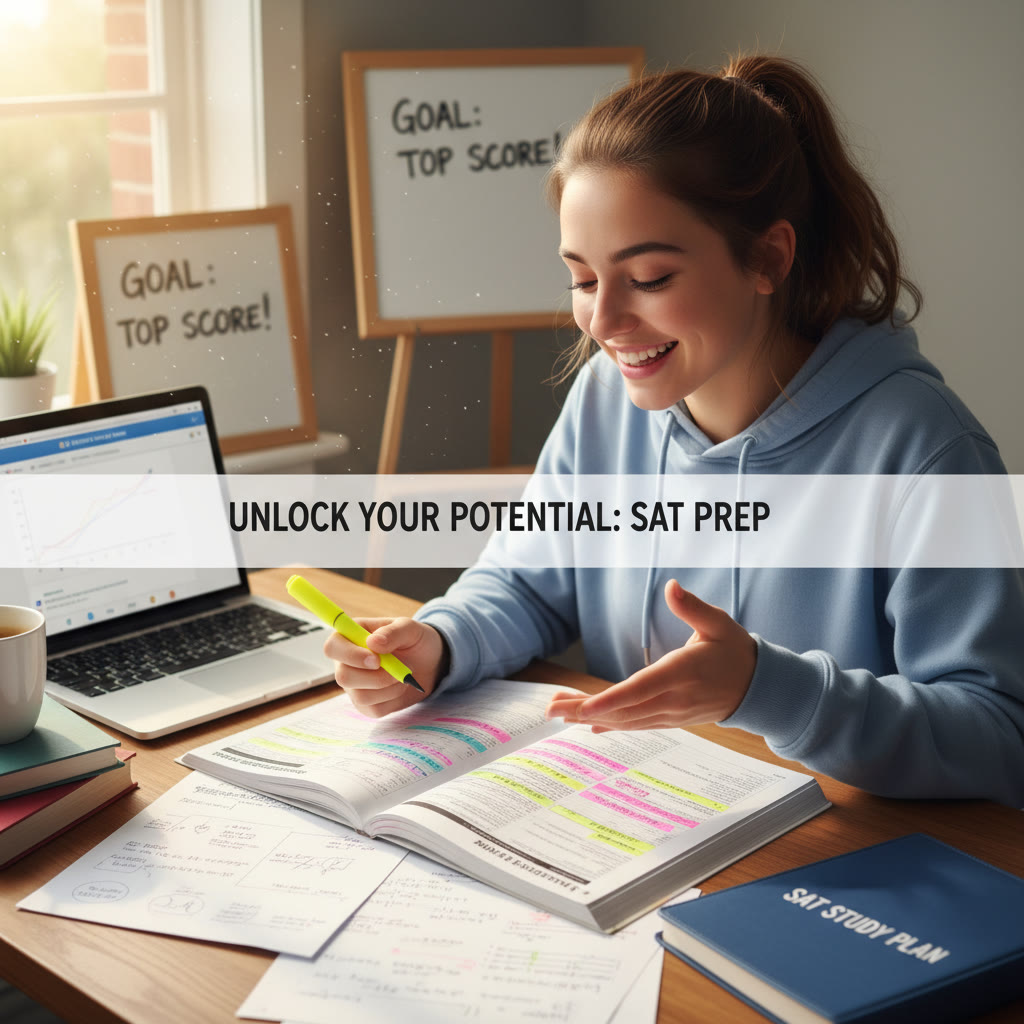The bigger picture: Why SAT prep is more than a test score
When you hear “SAT prep,” it’s easy to imagine stacks of practice tests, timed sections, and flashcards. That’s part of it, but framing SAT preparation as nothing more than score-chasing misses the best part: SAT prep strengthens skills that pay dividends across high school, college, and beyond. The habits you build while preparing—clear thinking under pressure, disciplined review, efficient reading, and smart problem solving—translate directly into classroom success.
From short-term goals to lifelong habits
Think about it this way: studying for the SAT asks you to do three things repeatedly and intentionally—learn content, apply strategies, and reflect on mistakes. Those three steps mirror effective academic work everywhere. Students who turn SAT prep into a training ground for high-quality study practices not only raise their test scores, they also arrive in class with sharper reading skills, better time management, and stronger confidence.

What the SAT actually measures — and what that means for learning
The SAT is often framed as a standardized snapshot of college readiness. More precisely, it measures a mix of content knowledge and cognitive skills: critical reading, evidence-based writing and language, mathematical reasoning, and problem translation. These are not isolated abilities. They connect directly to classroom tasks: interpreting a history passage, crafting a lab report, or solving algebraic modeling problems in calculus.
Skills, not tricks
While test strategies (like process of elimination or time allocation) help on test day, the most durable gains come from strengthening underlying skills. For example:
- Close reading on the SAT improves comprehension and annotation skills useful for literature and social studies.
- Working with algebraic concepts sharpens symbolic reasoning used in physics and advanced math.
- Evidence-based writing practice tightens the ability to construct clear, concise arguments—valuable in essays and lab write-ups.
Transferable skills you build during SAT prep
Below are specific skills SAT-focused work develops, and why each one matters in school.
1. Critical reading and synthesis
Regularly practicing reading complex passages trains you to spot the author’s main point, identify supporting evidence, and recognize subtle shifts in tone or perspective. In class, that looks like quicker comprehension of assigned readings, better note-taking, and more focused class discussions.
2. Precise problem solving
Many SAT math questions reward translating a word problem into a mathematical model. That skill—turning messy, real-world scenarios into structured equations—helps in science labs, economics problems, and any course that requires modeling.
3. Time management and pacing
The ritual of timed sections teaches pacing: how long to spend reading a paragraph, when to skip and return, and how to prioritize. Those strategies help with timed essays, in-class quizzes, and juggling multiple assignments during busy weeks.
4. Error analysis and metacognition
Perhaps the most underrated benefit: learning to analyze mistakes. If every wrong answer becomes a short investigation—what concept was shaky, which careless habit cost time—you develop metacognitive awareness that accelerates learning in every subject.
Concrete evidence: What study time can do (illustrative)
Different students see different gains depending on starting point, study quality, and coaching. The table below presents a practical, conservative illustration you can use as a planning tool—not a guarantee but a typical pattern educators observe when students combine focused practice with good feedback.
| Weekly focused SAT study (hours) | Typical improvement over 8–12 weeks (approx.) | Transferable classroom benefits |
|---|---|---|
| 2–4 hours | 10–40 points | Better quiz performance; improved essay structure |
| 5–8 hours | 40–100 points | Stronger algebra skills; faster reading comprehension |
| 9–15 hours | 80–160 points | Solid problem-solving routines; consistent time management |
Why the range? Because practice quality, targeted feedback, and rest matter. Ten hours of aimless question-drilling is less effective than five hours of focused practice with review and reflection.
Real-world examples: classroom wins inspired by SAT work
Let’s make this tangible with a few short stories that capture how SAT preparation translated into academic success.
Example: Reading with purpose
Jenna, a junior, started SAT prep focusing on passage mapping—underlining thesis sentences and annotating structure. Within a month, her history teacher noticed her more efficient annotations and improved participation. She began summarizing primary sources quickly and used evidence more confidently in essays. Her APUSH scores rose, and she reported spending less time rereading texts because she had learned to extract structure on the first pass.
Example: From equation to explanation
Marcus had trouble translating word problems into equations. Working through SAT math practice with targeted feedback, he learned to identify key variables and sketch quick diagrams. That approach transferred to physics problems: he started writing clearer problem statements, organizing knowns and unknowns, and showing work more systematically—producing fewer careless mistakes on tests.
How to design SAT prep that supports long-term academic growth
If your goal is college readiness, design SAT prep with transfer in mind. Here’s a practical roadmap.
Start with a diagnostic and a learning map
- Take a full, timed practice test to identify strengths and gaps.
- Create a learning map that links SAT skills to classroom goals (for example, critical reading → AP seminar performance).
Prioritize high-impact habits
- Active reading: annotate and summarize each paragraph in a sentence.
- Error journals: catalog every mistake type and write the fix.
- Mixed practice: rotate between reading, writing, and math to build flexible recall.
Use feedback loops
Your practice is only as valuable as the feedback you get. After each practice test or session, ask:
- Which mistakes were careless versus conceptual?
- What pattern do I see after three tests?
- What small change can I test next week?
Weekly plan example: balancing prep and schoolwork
Below is a balanced weekly plan that helps you make steady SAT progress without sacrificing classwork or extracurriculars.
| Day | Activity | Time |
|---|---|---|
| Monday | Targeted math practice (concept focus) + error journal | 60 minutes |
| Wednesday | Reading passages + active annotation practice | 45 minutes |
| Friday | Grammar & writing exercises + timed short essay | 45 minutes |
| Saturday | Full section (timed) + review | 90–120 minutes |
| Sunday | Rest, light review, flashcards | 20–30 minutes |
Make study sustainable
Short, consistent sessions outperform all-night marathon cramming. Keep sessions focused and finish each with a quick note on how you’ll change your next session—this turns effort into improvement.
How tutoring can amplify academic transfer
One-on-one guidance makes a big difference when the goal is more than a single test score. A skilled tutor helps you see the connections between test skills and classroom applications, tailors explanations to your learning style, and accelerates feedback loops.
What effective tutoring looks like
- Personalized study plans that integrate school deadlines and course content.
- Targeted feedback focused on patterns, not just single problems.
- Tools for independent practice—strategies you can reuse in classwork.
For students who choose tutoring, Sparkl’s personalized tutoring approach can be especially helpful: 1-on-1 guidance, tailored study plans, expert tutors, and AI-driven insights combine to give a clear pathway from current strengths to future goals. When tutoring focuses on skill transfer—not just test tactics—it becomes an investment in academic growth.
Practice tests: your lab for learning
Practice tests are more than score simulators; they are experiments. Treat each one as a controlled trial where you change only one variable at a time—a new strategy, a different pacing plan, or a focused review technique—and observe the result. Over time this experimental approach builds a personalized toolkit of tactics that work for you.
How to review a practice test effectively
- First, identify pattern errors across multiple tests, not just the single test.
- Next, write a one-paragraph summary of what you learned from the test and the top two changes you’ll make.
- Then, schedule targeted practice to address those changes in the next week.
Balancing SAT prep and school: priorities, not trade-offs
Many students worry that intense SAT prep will cannibalize academic performance. The reverse often holds: the right prep supports classroom work. The key is alignment. Select practice material that mirrors classroom skills—choose reading passages from related disciplines, use math problems that highlight concepts you’re encountering in class, and write practice responses on topics you study at school.
Avoiding burnout
Intensity without recovery leads to diminishing returns. Respect sleep, nutrition, and extracurricular time. Productive study plans are sustainable: they push you steadily while preserving energy for learning in class.
Measuring success beyond a single score
Score improvements are a concrete indicator of progress, but measuring academic success should be broader. Consider the following metrics:
- Quality of notes and summaries from complex readings.
- Reduction in careless errors on homework and quizzes.
- Improved time use—completing practice without last-minute panic.
- Greater confidence in tackling unfamiliar problems.
When these metrics move in the right direction, an improved SAT score usually follows—and the classroom benefits last long after the test.
Putting it together: a three-month action plan
Here’s a compact 12-week plan that balances focused skill work, practice tests, and classroom alignment.
- Weeks 1–2: Diagnostic and goal setting. Map weak areas to classroom needs and set a realistic score goal.
- Weeks 3–6: Intensive skill-building. Two focused sessions per content area per week, plus weekly timed practice sections.
- Weeks 7–9: Strategy refinement. Simulate exam conditions, refine pacing, and practice error analysis.
- Weeks 10–12: Consolidation and peak performance. Full-length tests every 7–10 days, light review the day before tests, and focus on confidence and routine.
If that structure feels overwhelming, consider working with a tutor who can tailor the plan to your calendar and learning style. Sparkl’s tutors specialize in creating individualized plans that integrate schoolwork and use AI-driven insights to identify the highest-impact activities—so your prep feeds your academic growth, not distracts from it.
Final thoughts: the lasting return on SAT preparation
Seen narrowly, SAT prep boosts a test score. Seen broadly, it’s practice in learning: mastering new information, diagnosing weaknesses, and building reliable systems for doing better next time. Those are the skills that make strong students—people who succeed in advanced classes, adapt quickly in college, and tackle unfamiliar challenges with confidence.
If you approach SAT prep as a chance to practice the habits of excellence—reflection, focused effort, and strategic improvement—you’ll get more than a number on a scoreboard. You’ll come out with a toolkit for learning that serves you across high school and into college. And if you want support making that toolkit efficient and personal, consider personalized tutoring options that combine expert guidance with tailored study plans and smart feedback—so that every practice session gets you closer to both your test and academic goals.

Takeaway checklist: How to make SAT prep boost your academic success
- Start with a diagnostic test and map weaknesses to school goals.
- Prioritize quality over quantity—targeted practice with review beats blind drilling.
- Use practice tests as experiments and keep a focused error journal.
- Align practice with classroom material to accelerate transfer.
- Invest in feedback—either from teachers, mentors, or a tutor—to shorten the learning curve.
- Keep the process sustainable: consistent short sessions and recovery beats burnout.
When you treat SAT prep as training for learning—rather than just training for a single exam—you build skills that lift your grades, sharpen your thinking, and prepare you for the next level. That connection between test prep and academic success is less a mystery and more a promise: practiced well, SAT work prepares you for better learning, not just better scores.



















No Comments
Leave a comment Cancel